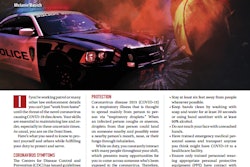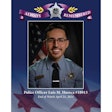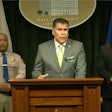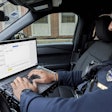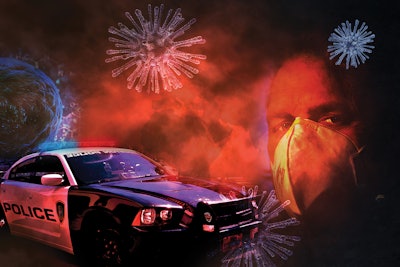 Illustration: Kevin Haegele, POLICE art director
Illustration: Kevin Haegele, POLICE art director
With the news full of reports about the novel coronavirus circulating around the globe (or COVID-19, as the disease caused by the virus is now officially known), this seems like the perfect time to think about the threats such viruses pose, especially for law enforcement officers. For some time now the U.S. Department of Justice has been aware of this issue. In fact, its paper "The Role of Law Enforcement in Public Health Emergencies," published more than a decade ago, warned that:
"Public health emergencies pose special challenges for law enforcement, whether the threat is manmade (terrorist attacks) or naturally occurring (e.g., flu pandemics)."
Of course, the threat to an officer's health in such circumstances depends on a variety of factors. Will you, for instance, be asked to enforce public health orders, such as quarantine orders or travel restrictions? Perhaps you will be required to seal off contaminated areas, guard health care facilities, or control unruly crowds. You might even be called in to protect vaccine stockpiles or other medical items.
Whatever the situation, you will be in the line of "viral fire," so to speak. So, how can you protect yourself from infection?
Well, the answer, like the question, is complicated. However, for the moment let's just focus on COVID-19 and what it means to you.
What is COVID-19
It's worth reminding people that, on January 31, 2020, Health and Human Services Secretary Alex Azar declared a public health emergency for the United States. The aim being to help the country's healthcare community to respond to COVID-19.
Like MERS-CoV and SARS-CoV, COVID-19 is a betacoronavirus, and they all have their origins in bats. As you probably know, the epicenter of the outbreak was in the Chinese city of Wuhan in Hubei Province. However, even though this suggests an animal-to-person spread early on, it is spreading person-to-person.
Symptoms
Since you deal with the public every day, you should be alert to the symptoms of COVID-19. The virus can take anywhere from two to 14 days to incubate, and even then, some of the infected may not exhibit any signs. However, know the main signs:
- Fever
- Cough
- Shortness of breath or difficulty breathing
Some victims have also reported having headaches, being excessively tired, and suffering from diarrhea. The fact is that COVID-19 can range in severity from very mild to acute. Older people or those with underlying medical conditions are especially at risk.
How to Protect Yourself
It is not inevitable that you will be infected by COVID-19, but the fact that you deal with many different people in many different circumstances every day means you are perhaps more vulnerable than others.
According to the CDC (Centers for Disease Control and Prevention), the virus spreads, "Mainly from person-to-person via respiratory droplets . . . [which are] produced when an infected person coughs or sneezes and can . . . be inhaled into the lungs of people who are nearby."
If you and/or your fellow officers should come into contact with a victim of the virus, try to do the following:
- Wear the proper personal protective equipment (PPE) and make sure it is correctly fitted. Use the 'buddy system' with your fellow officer(s) to check that each of you has followed protocols.
- If at all possible, try to maintain a distance of at least six feet from the infected person. This will prove difficult, but you should try nevertheless.
- Wash your hands (for at least 20 seconds) with soap and water as many times a day as is practical. If soap and water are not available, use an alcohol-based hand sanitizer.
- Very important: Avoid touching your face—especially your mouth, eyes, and nose—with unwashed hands.
- If you have to transport a COVID-19 victim to a hospital (or any health care facility for that matter) make sure a trained Emergency Medical Service/Emergency Medical Technician handles the actual transportation. Do not use your squad car!
What You Should Carry
It's almost inevitable that at some point you'll come into contact with a person who is—or is suspected of being—infected with COVID-19. You should carry some sort of Personal Protective Equipment (PPE). Of course, there are many different types of PPE, but at a very minimum you should have available:
- A pair of disposable examination gloves.
- A disposable isolation gown or single-use coveralls.
- A NIOSH-approved particulate respirator.
- Eye protection, e.g. goggles or disposable face shields that cover the entire face.
Of course, you may also come into close contact with (potentially infected) individuals if you are effecting an arrest. In which case, you should follow the CDC's guidelines on the subject:
- "Clean and disinfect duty belt and gear prior to reuse using a household cleaning spray or wipe, according to the product label.
- "Follow standard operating procedures for the containment and disposal of used PPE.
- "Follow standard operating procedures for containing and laundering clothes. Avoid shaking the clothes."
If you have any questions regarding the foregoing items consult the CDC's Interim Guidance for EMS.
Hope for the Best. Plan for the Worst.
If you are fortunate enough to be in a command position, you obviously have to be aware of the needs of the general public—and the safety and welfare of your officers. You need to define and communicate your goals should you, or one of your officers, contract COVID-19. There are at least four key objectives:
- Lowering transmission levels among the staff.
- Safeguarding those at higher risk from the virus.
- Continuing essential policing procedures.
- Reducing (as much as possible) the effects of your infection on other critical public services, such as fire departments, EMS, power and light companies, sanitation efforts and communications.
It's also very important that you have contingency plans in place to handle the increased numbers of absences because of employee and family-related illness. Cross-training your staff is one way of being able to carry out essential functions, even if your workforce is seriously depleted. But be prepared to change your plans so that you can maintain critical operations.
It goes without saying that you should make your plans known to those aforementioned critical public services and coordinate your efforts with theirs.
At this point it should come as no surprise that with COVID-19 we are dealing with a virus that is both versatile and, in some cases, deadly. However, despite all the media "excitement" and the fear that is now engulfing a large portion of the U.S. population, we have the knowledge and expertise to deal with this crisis.
In fact, there are many, many reliable resources you can turn to for help and advice. Here are some of the organizations whose publications will provide information you may find useful:
Centers for Disease Control and Prevention
Noel McCarthy has worked as a writer and editor throughout his career. A former director for Thomson Reuters, Noel also worked for PwC for 17 years. He is a staff writer for Steri-Fab.






